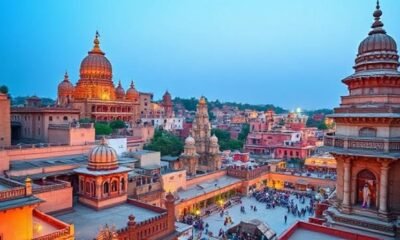Travel Guides & Articles
India and Philippines Announce Game-Changing Visa Waiver and Direct Flights to Supercharge Tourism

Published on
August 9, 2025 |
India is preparing to grant free e-visas to citizens of the Philippines, while the Philippines has already introduced visa-free entry for Indian travelers visiting for tourism. This reciprocal move is set against the backdrop of the 75th anniversary of diplomatic relations between the two nations. Both governments have framed the agreement as a symbol of trust and friendship, but also as a practical boost for tourism, trade, and cultural exchanges.
The Philippines’ visa-free policy for Indian nationals took effect on June 8, 2025. It allows Indian tourists to enter without the paperwork and fees previously required. India has announced its plan to offer a matching free e-visa to Filipino citizens, though an exact implementation date has yet to be confirmed. Once live, the arrangement will allow travelers from both sides to plan trips with minimal bureaucratic hurdles.
Celebrating a diplomatic milestone
The announcement was made during talks between Indian Prime Minister Narendra Modi and Philippine President Ferdinand Bongbong Romualdez Marcos Jr in New Delhi. The meeting coincided with celebrations marking 75 years of diplomatic ties between the two countries. To commemorate the milestone, a joint postage stamp was issued, reflecting shared history and forward-looking cooperation.
The leaders witnessed the signing of thirteen bilateral agreements covering multiple sectors such as defense, maritime cooperation, education, tourism, and trade. One of the most significant was the 2025–2028 tourism cooperation program, designed to guide joint initiatives, training, marketing campaigns, and sustainable travel projects over the next three years.
What the visa waiver means for travelers
For travelers, this agreement removes a major entry barrier. Filipino tourists will be able to apply for a free e-visa to visit India, which will be non-convertible and non-extendible, aimed strictly at short-term tourism. On the other side, Indian travelers already benefit from visa-free entry into the Philippines for tourism purposes.
This is expected to encourage not only leisure travel but also stronger cultural and educational ties. Plans are already being discussed for student exchange programs, cultural festivals, and academic collaborations. By allowing easier movement between the two countries, both governments are hoping to inspire long-term partnerships that go beyond tourism.
Direct flights to transform connectivity
Alongside the visa announcement, the Indian government confirmed it is working on more direct flight connections between Delhi and Manila. Air India announced in June 2025 that it would launch nonstop service between the two capitals starting October 1, 2025.
The flights will operate five days a week — Mondays, Wednesdays, Thursdays, Saturdays, and Sundays — using Airbus A321neo aircraft. The service will offer Business, Premium Economy, and Economy classes, appealing to both business travelers and leisure tourists.
Nonstop flights are expected to cut travel time significantly, removing the need for layovers in third countries. For both tourists and businesses, this will mean quicker, more convenient travel between India and the Philippines, potentially opening new avenues for trade, conferences, and cross-border projects.
Economic and cultural ripple effects
Tourism is one of the most immediate areas set to benefit from these changes. The Philippines is looking to attract a larger share of India’s fast-growing outbound tourism market, while India hopes to boost arrivals from the Philippines by offering a more accessible travel process.
Economic benefits are expected in hospitality, aviation, and retail sectors as visitor numbers grow. Cultural benefits could be equally significant. India’s diverse heritage, from the palaces of Rajasthan to the backwaters of Kerala, is now more accessible to Filipino travelers. Likewise, India’s travelers will have greater opportunities to experience the Philippines’ beaches, historical landmarks, and world-renowned hospitality.
Education and cultural diplomacy are also in focus. Easier travel can help universities, cultural organizations, and performing arts groups collaborate more frequently, enriching people-to-people connections.
Tourism ambitions backed by policy
The tourism cooperation agreement for 2025–2028 is a strategic move by both governments. It outlines commitments to joint marketing campaigns, knowledge-sharing in tourism development, and collaborative training programs for professionals in the hospitality and travel industries.
The Philippines has been actively promoting itself in India through roadshows, partnerships with tour operators, and participation in travel fairs. India’s Ministry of Tourism has similarly identified the Philippines as a priority market in Southeast Asia. With direct flights soon to be operational, these promotional efforts can be paired with convenient travel options to convert interest into actual bookings.
Timing and regional context
The announcement comes at a time when Asia-Pacific countries are seeking to revive tourism flows disrupted during the pandemic years. Simplifying visa rules and improving air connectivity are proven strategies to increase arrivals. For the Philippines, attracting Indian visitors — who are known for high spending during overseas trips — could provide a significant economic lift. For India, the Philippines offers an appealing mix of leisure, business, and investment opportunities.
The policy shift also supports broader regional goals. Stronger India-Philippines ties align with India’s Act East policy and ASEAN’s vision for deeper integration among member and partner nations.
The symbolism of shared milestones
The joint postage stamp may seem a small gesture, but in diplomatic terms, it carries weight. It represents continuity, mutual respect, and a shared journey over decades. Linking that symbolism to practical steps like visa waivers and flight agreements makes the celebration tangible for citizens.
By tying the policy changes to the 75th anniversary of diplomatic relations, both governments are signaling that the relationship is not just about official visits but about creating everyday opportunities for their people.
Tourism cooperation roadmap 2025–2028
The implementation plan for tourism cooperation lays out concrete goals for the next three years. Joint marketing will target both traditional and emerging traveler segments. Data sharing will help each country understand visitor behavior and preferences. Hospitality training programs will focus on raising service standards to match the expectations of increasingly diverse tourist groups.
Sustainability is also built into the plan. Both nations are aiming to ensure that tourism growth does not compromise environmental or cultural integrity, with eco-friendly practices encouraged for tour operators, hotels, and other stakeholders.
Challenges and strategies
Turning these announcements into reality will require coordinated efforts. India’s rollout of the free e-visa must be smooth and accessible, with clear guidelines for Filipino travelers. The new Delhi–Manila flights will need strong marketing to maintain high passenger loads beyond the launch period.
Possible strategies include promotional fares for early bookings, collaborative tour packages offered by operators in both countries, and seasonal campaigns tied to festivals or events. Close cooperation between tourism boards, airlines, and travel industry bodies will be crucial.
Air India’s role in the new travel corridor
Air India’s choice of the Airbus A321neo reflects careful planning. This aircraft type offers an efficient balance of range, passenger capacity, and fuel savings for the route’s demands. The five-times-weekly schedule provides enough frequency to be practical while allowing adjustments based on seasonal demand.
If the route proves successful, additional frequencies or connections from other Indian cities to Manila could follow, deepening the travel corridor between the two nations.
People-to-people impact
Perhaps the most meaningful changes will be felt at a personal level. Families with members in both countries will find it easier to visit one another. Students will face fewer barriers to studying abroad. Artists, cultural groups, and entrepreneurs will have more opportunities for direct collaboration.
These everyday connections can create bonds that outlast political terms and policy cycles. Over time, the familiarity and friendships built through travel often contribute to stronger diplomatic ties than formal agreements alone.
Outlook for the future
The mutual visa waiver and new direct flights signal a confident outlook for India-Philippines relations. By making travel easier and more appealing, both nations are opening doors to a future of deeper economic cooperation, richer cultural exchange, and sustained tourism growth.
When the first Air India flight departs Delhi for Manila on October 1, 2025, it will carry not just passengers but the weight of a new era in bilateral ties. And when Filipino travelers begin arriving in India with free e-visas in hand, the practical benefits of this diplomatic milestone will be visible in airport arrival halls, hotel lobbies, and tourist landmarks across both nations.
Travel Guides & Articles
Tharoor calls for targeted campaigns beyond ‘Incredible India’ to boost tourism

Calling for a more nuanced and diversified promotional strategy, Dr Shashi Tharoor, Member of Parliament, has urged India’s tourism sector to move beyond the singular “Incredible India” campaign and adopt a more segmented approach to marketing the country’s vast and varied offerings. He emphasised the need to highlight niche sectors such as wildlife, beaches, heritage, and culture, arguing that a one-size-fits-all campaign is insufficient to reflect India’s diversity. “One ‘Incredible India’ campaign is not enough,” Tharoor said. “We need to showcase the many different aspects of India that exist within our borders.”
Speaking at the Skål India National Congress 2025 in Mumbai, he also pointed to the glaring absence of Chinese tourists in the country, despite their growing presence in global tourism. “The Chinese are travelling across the world except India. Let’s bring some Chinese money into our country,” he remarked.
Adding a touch of humour to his address, Tharoor quipped, “Perhaps we could even attract some British tourists for a colonial heritage tour—though there aren’t many monuments left; they took more than they left.”
His remarks added both insight and levity to a serious discussion on revitalising Indian tourism, offering clear and actionable ideas to industry leaders and policymakers alike.
Tharoor also called for urgent structural reforms in the tourism sector, highlighting the need to enhance women’s safety and strengthen hospitality infrastructure across the board. “Our nation carries the perception that India is not safe for women. We must change this image. It’s time for action. Increasing the presence of women police officers in tourist areas would be a step in the right direction,” he stated.
He emphasised tourism’s role as a key driver of economic growth, citing its potential to create employment and generate significant revenue. “We have a lot to do. Tourism is a vital sector—it generates jobs and enhances government income. Infrastructure development must be prioritised.”
Pointing to gaps in the current hospitality ecosystem, he added, “We either have high-end five-star hotels or substandard facilities—there’s virtually nothing in the middle. We need to build a lot more to fill this gap.”
Tharoor’s address reflected a mix of strategic insight and wit, resonating with tourism professionals, investors, and policymakers seeking to position India as a more attractive and accessible global destination.
Travel Guides & Articles
Where to Shop for Jewelry in Jaipur, India

From left: Courtesy of Santi; Abhishek Bali
Jaipur has long seduced travelers with its warren of old bazaars, royal palaces, and glittering treasures. But behind one of the city’s pink façades lies a rarer find: Royal Gems & Arts, a jewelry business housed inside Saras Sadan, an 18th-century haveli, or mansion, a short walk from the iconic Hawa Mahal palace.
Run by ninth-generation jeweler Santi Choudhary with his wife, Shobha, and son, Krishna, the atelier feels like a museum and is open by appointment only. The Choudharys, descendants of the city’s founding families, supply exquisite pieces to royalty and collectors around the world.
Today, Santi oversees a trove of Mughal- and Rajput-inspired pieces, some of which have been loaned to the world’s top museums. Krishna joined the family business while studying Islamic and Indian art in London. In 2019, he started his own label, Santi, with an atelier in London’s Mayfair district showcasing bold, contemporary designs with rare stones set in gold, titanium, or platinum.
Together, the Choudharys’ shops offer a glimpse into India’s past and present—one rooted in Jaipur’s traditions, the other reinterpreting them for a new generation. While the haveli in Jaipur focuses on heritage designs, Santi in London crafts one-of-a-kind pieces, like a rare 18th-century, pyramid-shaped Colombian emerald set in 18-karat white gold with reverse-set diamonds. “Every antique stone we work with brings a mystery with it, and we add something to it for the future,” Krishna says.
Courtesy of Santi
Run by ninth-generation jeweler Santi Choudhary with his wife, Shobha, and son, Krishna, the atelier feels like a museum and is open by appointment only. The Choudharys, descendants of the city’s founding families, supply exquisite pieces to royalty and collectors around the world.
Today, Santi oversees a trove of Mughal- and Rajput-inspired pieces, some of which have been loaned to the world’s top museums. Krishna joined the family business while studying Islamic and Indian art in London. In 2019, he started his own label, Santi, with an atelier in London’s Mayfair district showcasing bold, contemporary designs with rare stones set in gold, titanium, or platinum.
Together, the Choudharys’ shops offer a glimpse into India’s past and present—one rooted in Jaipur’s traditions, the other reinterpreting them for a new generation. While the haveli in Jaipur focuses on heritage designs, Santi in London crafts one-of-a-kind pieces, like a rare 18th-century, pyramid-shaped Colombian emerald set in 18-karat white gold with reverse-set diamonds. “Every antique stone we work with brings a mystery with it, and we add something to it for the future,” Krishna says.
More Must-visit Jewelers in Jaipur
Founded by Akshat Ghiya—a second-generation jeweler who was raised in India and Italy—this store has made a name for itself with its unconventional, contemporary pieces. Ghiya uses stones like pink and purple sapphire, onyx, citrine, and tourmaline to create wearable confections.
This shop, which features striking geometric styles, is attached to a museum that holds more than 2,500 objects—textiles, coins, daggers, and jewelry—collected by the owners’ late father.
Established in 1852, this store is a celebrity favorite. Princess Diana, Oprah, and Gwyneth Paltrow have all ogled the traditional Indian craftsmanship blended with contemporary design. After the eighth-generation jeweler Munnu Kasliwal died in 2012, his son Siddharth took over, and today runs the business alongside his brother, cousins, and uncle.
A version of this story appeared in the October 2025 issue of Travel + Leisure under the headline “Jaipur’s Crown Jewel.”
Travel Guides & Articles
PM Modi inaugurates Purnia Airport Terminal: A new gateway to Seemanchal |

The Indian Prime Minister Narendra Modi recently inaugurated the new interim terminal building at Purnia Airport. Purnia is among Bihar’s one of the most crucial towns in the Seemanchal region. The facility has a record time of less than five months and it is now all about opening doors to growth, tourism, and opportunity in a new region.The inauguration was part of projects worth over INR 40,000 crore launched across Bihar. These include new trains, road and rail upgrades, housing initiatives, and community development programs. At the inauguration, PM Modi mentioned how important Seemanchal’s progress is a vision of a “Viksit Bihar” and, ultimately, a “Viksit Bharat.” He also talked about the government’s commitment to ensuring every family has a proper home under the PM Awas Yojana, with 40,000 families in Bihar receiving houses under the scheme. The message was clear: development in this region is not just about infrastructure but also about dignity and better living.As far as travellers are concerned, the prime highlight is that Purnia will now find itself on India’s aviation map. There are commercial flights already taking off from the new terminal which is a huge achievement. This means easier access to Seemanchal for both business visitors and tourists.For a traveller, this new terminal shows smoother journeys and a modern point of arrival in Purnia. The facility’s timely construction also shows an urgency to improve Bihar’s connectivity on an urgent level. The surrounding projects add to this transformation. The doubling of railway lines between Bhagalpur, Dumka, and Rampurhat, as well as plans for a high-speed rail corridor connecting Mokama and Munger to Buxar and Bhagalpur, promise faster and more reliable transport in the years to come.
The developments go beyond transport too. A major river link project between Kosi and Mechi aims to support irrigation and reduce the impact of floods, which will eventually make rural tourism in the area more accessible.
For those planning a trip, the improved connectivity puts Purnia within easier reach. The region has long remained off mainstream travel itineraries, but with flights now operational, visitors can explore Seemanchal’s blend of rural landscapes, cultural diversity, and developing infrastructure. Whether you’re arriving for work or leisure, the experience of landing in Purnia has already changed — you step into a terminal that represents progress and possibility.The successful story of Purnia’s new airport terminal is about more than bricks and mortar. It is about linking a once-distant corner of Bihar to the wider world and inviting travellers to look at the region with fresh look.
-

 Business3 weeks ago
Business3 weeks agoThe Guardian view on Trump and the Fed: independence is no substitute for accountability | Editorial
-
Tools & Platforms1 month ago
Building Trust in Military AI Starts with Opening the Black Box – War on the Rocks
-

 Ethics & Policy2 months ago
Ethics & Policy2 months agoSDAIA Supports Saudi Arabia’s Leadership in Shaping Global AI Ethics, Policy, and Research – وكالة الأنباء السعودية
-

 Events & Conferences4 months ago
Events & Conferences4 months agoJourney to 1000 models: Scaling Instagram’s recommendation system
-

 Jobs & Careers3 months ago
Jobs & Careers3 months agoMumbai-based Perplexity Alternative Has 60k+ Users Without Funding
-

 Podcasts & Talks2 months ago
Podcasts & Talks2 months agoHappy 4th of July! 🎆 Made with Veo 3 in Gemini
-

 Education3 months ago
Education3 months agoVEX Robotics launches AI-powered classroom robotics system
-

 Education2 months ago
Education2 months agoMacron says UK and France have duty to tackle illegal migration ‘with humanity, solidarity and firmness’ – UK politics live | Politics
-

 Podcasts & Talks2 months ago
Podcasts & Talks2 months agoOpenAI 🤝 @teamganassi
-

 Funding & Business3 months ago
Funding & Business3 months agoKayak and Expedia race to build AI travel agents that turn social posts into itineraries





















